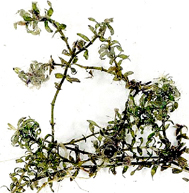ScienceSource Supplemental Lab Activity | Unit A - Chapter 1 |
Investigating Science 10 | Inquiry Activity |
Counting Chloroplasts
Skills Reference 2, 10
Skills you Will Use
- Using equipment, materials, and technology accurately and safely
- Drawing conclusions
Safety
The aquatic plant Elodea canadensis is native to most parts of Canada. Elodea grows in ponds, anchored to the bottom. It has a tube-like stem with many small, thin leaves growing from it. Similar South American species are used in aquariums. Small fish eat the leaves, but primarily the leaves of the plant provide protection and shelter for the fish.
Question
How many chloroplasts are present in a typical cell of an Elodea canadensis leaf or the leaf of another aquatic plant?
Materials and Equipment
- aquarium water
- petri dish
- forceps
- Elodea canadensis, Java moss, or other aquatic plant
- glass slide and cover slip
- dropper
- compound light microscope

Procedure
- Transfer some water from the aquarium where the plants are kept into a petri dish.
- Using the forceps, place a section of the plant you are to study into the petri dish of water.
- Use the forceps to carefully remove one small, thin leaf from the plant and place it on a clean glass slide.
- Make a wet mount of the leaf. Be careful not to include air bubbles under the cover slip. See Skills Reference 10 at the back of the student book to review how to make a wet mount.
- Examine the slide through the microscope using the low-power objective. Find an area where the cells are clearly visible. Switch to high power so that you can see organelles in the cell. The round, green organelles are chloroplasts. The leaf is two cell-layers thick. Use the fine adjustment knob to focus up and down through the layers.
- Draw what you see in the field of view. Create a data table and record the number of chloroplasts present in each of 10 cells. Find the average number of chloroplasts per cell.
- Compare the number of chloroplasts in cells near the edge of the leaf and in cells in the middle of the leaf.
- Draw one chloroplast. Label your diagram with the name of the plant and the total magnification used.
- Estimate the actual size of the chloroplast by comparing it with the diameter of the field of view, using the technique you learned in Skills Reference 10.
- Try to distinguish the cell wall in these chloroplast-packed cells. The central vacuole is also present but it is difficult to see because it is transparent and filled with water.
- Continue to observe the chloroplasts. What do you notice about their position in the cell? Are they moving or stationary? Record your observations.
Analyzing and Interpreting
- Were there significant differences in the number of chloroplasts in cells near the edge of the leaf compared with the middle of the leaf? Provide a possible explanation for your observation.
- Describe the movement of the chloroplasts in the cell. This movement is often termed cytoplasmic streaming. What do you think its function is? Are the chloroplasts of the same cell moving in the same direction? Are the chloroplasts of all the cells in the field of view all moving in the same direction?
Skill Practice
- Before you began this activity, your teacher exposed the plant or plants being studied to light for an hour or so. Why do you think this was necessary?
Forming Conclusions
(a) Based on your observations, how many chloroplasts are present in a typical cell of an Elodea canadensis leaf or other aquatic plant?
(b) Describe the role of these organelles in the cell.
